A Pocket Cathedral: The Kelmscott Chaucer
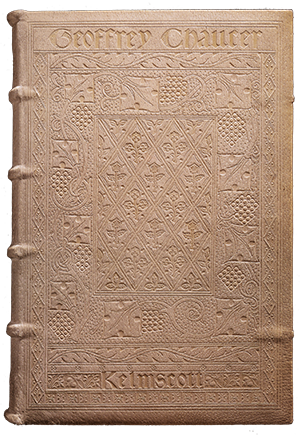
The Works of Geoffrey Chaucer published in 1896 by the Kelmscott Press was the culmination of William Morris's vision for an ideal book. It embodied his love of medieval literature and art, as well as his love of beauty. Its vast scope and magnificence inspired his friend and collaborator Edward Burne-Jones to compare it to a "pocket cathedral."
William Morris and Edward Burne-Jones discovered and developed a love for Chaucer as undergraduates at Oxford University. After Morris established the Kelmscott Press in 1891, the two old friends agreed that The Canterbury Tales and other works by Chaucer would be a major goal for the enterprise. Morris spent four years working on the book. Trial pages were printed in 1892, while final production began on August 8, 1894. The first two copies of the book were delivered to Morris and Burne-Jones on June 2, 1896. Morris was already in failing health; he died four months later on October 3, 1896.
Image: The pigskin binding designed by William Morris for the Doves Bindery to produce for forty-eight copies of the Kelmscott Chaucer, 1896.
"Indeed when the book is done, if we live to finish it, it will be like a pocket cathedral - so full of design and I think Morris the greatest master of ornament in the world"
- Edward Burne-Jones, Letter to Charles Eliot Norton, 1894 -
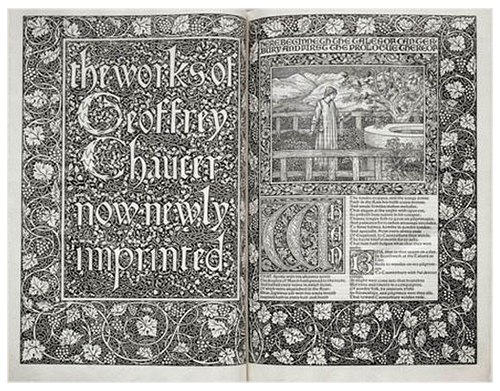
The Works of Geoffrey Chaucer, Now Newly Imprinted
by Geoffrey Chaucer
Hammersmith: Kelmscott Press, 1896
In December 2010 the University of Maryland Libraries acquired one of 425 copies of The Works of Geoffrey Chaucer printed on paper in 1896. The Chaucer was the crowning achievement of William Morris and his Kelmscott Press. It now constitutes the greatest treasure of the Libraries' already impressive William Morris Collection. The Kelmscott Chaucer is often referred to as one of the most beautiful printed books in existence. Some of the features of this unusual book include: 556 pages, 87 illustrations by Edward Burne-Jones, 14 large and 18 smaller borders, 26 large initial words, printed in black and red in Chaucer type.
Edward Burne-Jones and William Morris in 1890
Frederick Hollyer photograph
The Kelmscott edition of Chaucer's works represents the culmination of William Morris and Edward Burne-Jones's artistic partnership. Morris and Burne-Jones had met more than 30 years previously when they were in the same college at Oxford. Over the years they travelled abroad together, joined the Pre-Raphaelites, worked together at Morris, Marshall, Faulkner, & Co., and collaborated on many book projects.
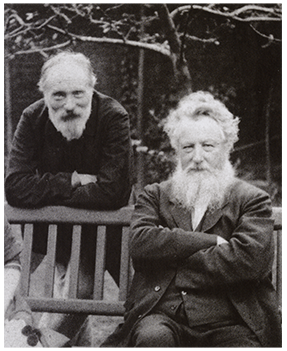

William Morris and Edward Burne-Jones being blessed by Chaucer
Cartoon by Edward Burne-Jones, 1896
Burne-Jones produced the 87 illustrations which were engraved on wood for the Chaucer. Morris produced the frames, borders, and initials which surrounded the illustrations, and designed the type and layout of the work. Burne-Jones usually worked on the Chaucer illustrations on Sundays, when Morris visited his studio to talk and read aloud.
Kelmscott Chaucer: Two Specimen Leaves on Vellum
by Geoffrey Chaucer
Hammersmith: Kelmscott Press, 1896
Pages taken from an original vellum copy of Chaucer's Works
A comparison of Edward Burne-Jones's original drawing with the final wood engraving in the Chaucer shows how much work had to be done to translate the delicate shaded drawing into a version with strong lines that could be engraved.

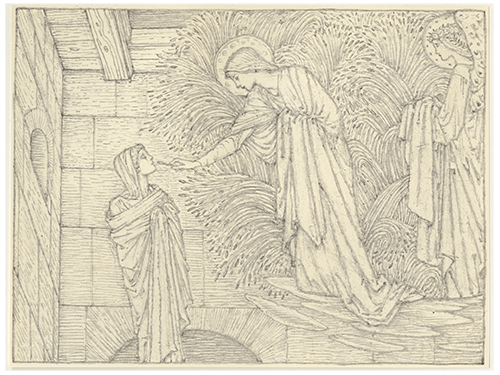
Edward Burne-Jones's original sketch of the "Prioress's Tale"
Duncan Robinson. A Companion Volume to the Kelmscott Chaucer
London: Basilisk Press, 1975
Emery Walker provided photographs of the drawing. After covering the photograph with a wash of Chinese white, Robert Catterson-Smith reworked the image with bolder lines. This revised drawing was transferred photographically to the surface of the woodblock and engraved by William Hooper.
Prioress's Tale Wardrobe, 1859
Edward Burne-Jones's illustration for the Prioress's Tale was based on his painting of the same scene on the wardrobe he gave to William and Janey Morris as a wedding present. This wardrobe is now in the Ashmolean Museum in Oxford, England.
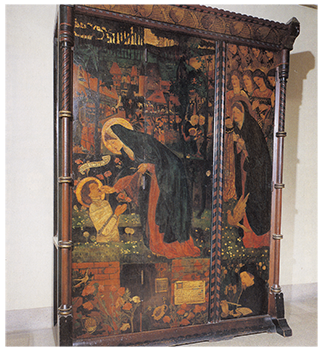

William & Sylvia Holton Peterson
The Kelmscott Chaucer: A Census. 2011
The Kelmscott Chaucer joins such famous books as The Gutenberg Bible and Shakespeare's First Folio with a census of known copies: The Kelmscott Chaucer: a census by William and Sylvia Peterson. Of the 425 paper copies and 15 vellum copies of the Chaucer, the Petersons have documented approximately two-thirds of the total. The University of Maryland Libraries recently acquired a previously undocumented copy of the Chaucer. Although it was too late to be included in the census, the Petersons have established a blog to provide updates as more copies emerge.
